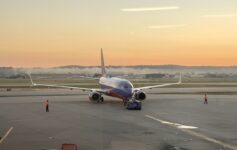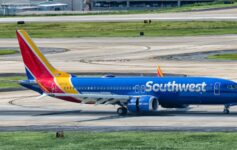Southwest has unveiled more changes and a new international partnership in its pivot from Low Cost Carrier to standard network airline.
If you are considering booking travel or signing up for a new credit card please click here. Both support LiveAndLetsFly.com.
If you haven’t followed us on Facebook or Instagram, add us today.
Southwest Airlines Former Identity
In 1990s, Southwest moved from a quiet little niche Texas airline to a national powerhouse. The Southwest Effect would lower fares in a new city as the airline expanded by an average of 15% and increased travelers through that airport by 28-30%. The no frills approach was an inferior offering to network carriers at the time who were still offering two checked bags, meals in coach even on short flights, and point-to-point service over congested hub and spoke models.
As the market changed, mostly after September 11th, Southwest stayed the same. What once was a constant compromise for travelers using secondary airports (Manchester, New Hampshire instead of Boston Logan) and forgoing service onboard, became industry-leading with included luggage, one of the most widespread internet install bases, and a cancellation policy that has long allowed travelers to hold onto their value for a future trip.
They were also less expensive, but that’s not been the case for more than a decade.
Southwest and IcelandAir Partnership
Southwest Airlines and IcelandAir announced a partnership that will take flight in 2025. It will allow Southwest flyers to book and redeem for flights to Europe and for European travelers to reach greater US destinations. Many of Southwest’s destinations are already served by IcelandAir in a meaningful way offering greater onward connections. Several of those 14 North American destinations are in focus cities for Southwest’s network such as Denver (DEN), Baltimore (BWI), Nashville (BNA), and Orlando (MCO.)
This is not the first time that Southwest has joined forces with a foreign carrier. Southwest’s initial partner was when it codeshared with WestJet for some time before ending the airline partnership. It also sought a tie-up with Volaris in 2009 for onward service throughout Mexico.
IcelandAir may be different than the others because its customer base has changed. Now, the airline flies into major hubs it fought hard to avoid such as LaGuardia, Dallas/Fort Worth, and Chicago O’Hare. It serves more business flyers than ever before (though they are pulling back some now.)
Seating Plan Fully Unveiled
Its signature “sit wherever you want” cattle call has been retired in favor assigned seating. This is, of course, to drive and segment revenue. Assigned seats with access to more space will coincide with more expensive fares, and in time with the ability to buy up just the better seat assignment. Premium seats for now are limited to more space in some coach seats while reducing space throughout the rest of the cabin.
When Southwest announced the assigned seating plan, some had believed it was solely to expedite seating, reward more frequent customers, or those flying on higher value fares. But it’s clear that’s not going to be the case.
The airline has, for now, stated it will keep two free checked bags, but like everything else in the march toward improving shareholder value will be subject to investor approval.
All of the moves that the carrier has made are standard network carrier moves because it’s facing standard network carrier problems. American, Delta, and United have 952, 947, and 924 aircraft respectively. Southwest comes in fourth at 814, a sizable fleet. For comparison, the next closest carrier is SkyWest (which serves the others on feeder flights) at just less than 500. Alaska comes in at 365 (426 with Hawaiian.) Southwest had 171 million enplaned passengers, ahead of United by 7 million in 2023.
Just as the other carriers have found value in segmenting passengers and ancillary revenue, so too is Southwest – the last hold out – joining the ranks.
Who The Carrier Is Now, And What’s Next?
Southwest is at a confusing juxtaposition. In order to continue to grow, it’s going to need to further segment, offer something below its mostly included model, and add further partnerships. The airline has few destinations in the United States for which it can continue to add meaningful seats and revenue. And as its customer base changes, so too will its partnerships. Past relationships were to serve near field markets on leisure routes. The future is going to be offering something more premium.
Alaska demonstrated a model of adding partners across alliances (before it joined oneworld) that helped its customers move around the world on airline partners like Air France, British Airways, and Emirates. While onward connections likely helped Emirates passengers get elsewhere in North America, redemptions were likely the reason that partnership devolved.
Today, some Southwest passengers want to go to Paris, London, or Rome and before the IcelandAir partnership, they have to choose other carriers for those destinations. This is the lowest hanging fruit, but is it enough? I’d argue that Southwest customers probably want to go deeper throughout the Caribbean than the handful of destinations the airline offers. Perhaps it’s helpful to look outside of airline relationships too like cruise lines, and hotel chains. Hyatt and American have found success in their relationship, Marriott and United have a deal, Delta and SPG pioneered this type of partnership. Maybe Southwest and Hilton will get together. Maybe something a little more unique like Sandals/Beaches resorts as Southwest flies to many of Sandals’ resort destinations.
As crazy as it sounds, Southwest may have to consider an alliance membership too. Southwest is large enough to become an anchor for a new alliance and there are likeminded carriers without an alliance that could help Southwest expand its wings, and for global carriers to gain access to more US destinations. Attractive global carriers like Emirates, Etihad, Starlux, and IcelandAir could help to build a broader footprint. As we’ve seen in recent years, some carriers like SAS, have switched from one to another, that too could happen.
We can’t forget the comments that Southwest’s Boeing exposure has put the airline in a compromised situation. This could mean new airframes from Airbus. And while we are breaking the aircraft mold Southwest has occupied, we may also want to find some products better suited to its missions, including A220s for longer, narrow markets.
The only thing we know for sure is that Southwest will have to continue to evolve in a way that it hasn’t before. It’s not the same Southwest it has been and probably shouldn’t be thought of as such.
What do you think?




I can recognize individual female FAs from their legs in their formerly-worn miniskirt uniforms .
Certain legs I never forget .
Especially the ones with a pair of hairy nuts hanging under that skirt.
Are you suggesting an alliance with Alaska /Hawaiian Airlines? Fast track connections with Ryanair and EasyJet? Boliviana de Aviación to South America?
Elliott is supposedly working on launching TATL service from BNA and MCO to LHR, CDG, FRA, FCO, MAD, and MXP, all in time for next summer. Those routes will be year-round, with LIS, BCN, ATH, AMS, BRU, and NCE flown seasonally, all using single class 737-MAX8s with lie flat in the front and extra legroom near the lavs. The plan is to turn BNA into the next ATL in 1-3 years.
The Max does not have that range and it’s not single class if it has lie flat in the front and extra legroom in the back.
But, wouldn’t it be fun to hop on a BNA-LHR flight, hearing the captain say the flight is 6,729 km knowing the Max8 has a range if 6,570 km? MCO would fe fun too at 200 km farther.
Nope. Not my kind of deep sea exploration.
I think the comment is sarcastic. The plane doesn’t have the capability, and neither does BNA– not in the next 9 months as described.
Adding Airbus into the mix would throw a huge wrench into their maintenance and related operations. Yes, other airlines do it, but this has been a core part of their operating model since day one and would be very difficult to implement, even given the additional operational flexibility it would provide.
Then again, who would have thought they’d given up their cattle car seating or changed their pricing to be basically the same as everyone else?
They have mentioned near the beginning of the year that they would be open to Airbus if Boeing MAX-7s can’t achieve a certification.
Southwest will be glad to hear that they can fly to DFW already (Spoiler: they can’t).
Until 2025…
I just think it’s a shame that an airline that operated for so long on a spirit of innovation now seems to be moving so fast toward conformity. Business schools around the world used to study Southwest for its innovative culture and labor practices. Perhaps it will be studied in the future to show how corporations inevitably gravitate towards the mean.
100% this. JetBlue lounges, Spirit re-bundling, United/Delta/American basically being indistinguishable for the common flyer – it’s all an example of that.
Those in the Southwest C-Suite are very much to blame for the current situation.
It stood mute as the “reserved seating” and “Jesus Jetway” crowd got totally out of hand. One simple announcement of “no seats are reserved” during the boarding process would have mitigated the frustration. Also, adding two or three rows to the front with extra legroom and a complementary beverage could have been verified via boarding passes while the remainder of the cabin was open seating. Again, a lost opportunity.
Now, corporate raiders are standing at the gate baying for blood!!
I have no empathy for Southwest management.